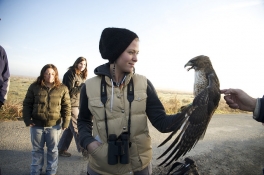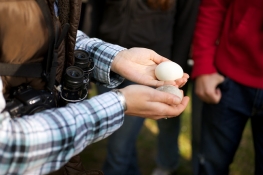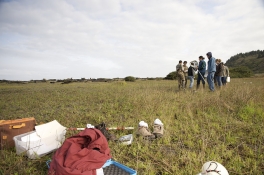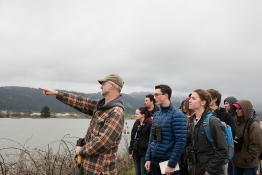Humboldt Bay Goose Study
Goals include gathering data that will be useful to policy makers when addressing socio-political issues dealing with the geese in the Arcata area. There are several study objectives.
- assess habitat preferences and diet in all seasons
- determine habitat characteristics of roosts, nests and brood-rearing sites
- determine energy budget in relation to disturbance (natural and human mediated)
- determine carrying capacity of habitats
- assess response of goose plant-foods to grazing and fertilizing from goose droppings
- determine fate of broods & lifetime reproduction of marked birds
- determine movement of marked individuals throughout range
Goose Data Entry
The Humboldt waterfowl research group will also address questions dealing with traditional use of sites, mate choice, divorce, pair bond tenacity, extra-pair behavior, adoption and parental care.
There are 2 species of geese that make use of Humboldt Bay during their migration: Aleutian Cackling Geese (Branta hutchinsii leucopareia), and Black Brant (Branta bernicla). These geese nest in Alaska and winter with us in California. Numbers in these populations are approaching 100,000. Whereas the Black Brant stimulate new growth in their food in the bay (Zostera), Aleutians compete for limited pasture grass with local livestock. Look for blue neck collars on the Aleutians and smaller leg bands on the Brant.
A third species nests in the marshes and farmland around the bay: Western Canada Geese (Branta canadensis moffitti). Members of this ”resident“ flock have been recovered as far north as British Columbia and Alberta, but most return and spend their time right around the bay. This population fluctuates between 1,000 – 3,500 individuals. Look for and report big black neck collars on Western Canadas.
Highlights
Information for Students
Students will be encouraged to record the location of foraging flocks and individually marked geese. In particular, participation will be expected from students in Waterfowl 420, Wildlife Techniques 311, and Wildlife Ethology 475.
- Find out how to contribute to the study - Go to WCG resightings
- Make use of the Waterfowl identification - study session

- Fat scores - You may attribute a field index to each bird by determining the fatness of the abdomen. Make sure the bird is parallel to the observer and check whether it is 0=concaved/thin, 1=straight, 2=convex, 3=rounded, 4=well rounded/bulging. With practice, you may see that some fat scores fall between two index-points, so a score of 0.5, 1.5, 2.5, or 3.5 may be more appropriate.






 Enter your data »
Enter your data »